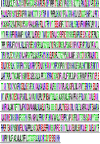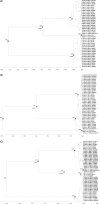Genetic characterization of Betacoronavirus lineage C viruses in bats reveals marked sequence divergence in the spike protein of pipistrellus bat coronavirus HKU5 in Japanese pipistrelle: implications for the origin of the novel Middle East respiratory syndrome coronavirus
- PMID: 23720729
- PMCID: PMC3719811
- DOI: 10.1128/JVI.01055-13
Genetic characterization of Betacoronavirus lineage C viruses in bats reveals marked sequence divergence in the spike protein of pipistrellus bat coronavirus HKU5 in Japanese pipistrelle: implications for the origin of the novel Middle East respiratory syndrome coronavirus
Abstract
While the novel Middle East respiratory syndrome coronavirus (MERS-CoV) is closely related to Tylonycteris bat CoV HKU4 (Ty-BatCoV HKU4) and Pipistrellus bat CoV HKU5 (Pi-BatCoV HKU5) in bats from Hong Kong, and other potential lineage C betacoronaviruses in bats from Africa, Europe, and America, its animal origin remains obscure. To better understand the role of bats in its origin, we examined the molecular epidemiology and evolution of lineage C betacoronaviruses among bats. Ty-BatCoV HKU4 and Pi-BatCoV HKU5 were detected in 29% and 25% of alimentary samples from lesser bamboo bat (Tylonycteris pachypus) and Japanese pipistrelle (Pipistrellus abramus), respectively. Sequencing of their RNA polymerase (RdRp), spike (S), and nucleocapsid (N) genes revealed that MERS-CoV is more closely related to Pi-BatCoV HKU5 in RdRp (92.1% to 92.3% amino acid [aa] identity) but is more closely related to Ty-BatCoV HKU4 in S (66.8% to 67.4% aa identity) and N (71.9% to 72.3% aa identity). Although both viruses were under purifying selection, the S of Pi-BatCoV HKU5 displayed marked sequence polymorphisms and more positively selected sites than that of Ty-BatCoV HKU4, suggesting that Pi-BatCoV HKU5 may generate variants to occupy new ecological niches along with its host in diverse habitats. Molecular clock analysis showed that they diverged from a common ancestor with MERS-CoV at least several centuries ago. Although MERS-CoV may have diverged from potential lineage C betacoronaviruses in European bats more recently, these bat viruses were unlikely to be the direct ancestor of MERS-CoV. Intensive surveillance for lineage C betaCoVs in Pipistrellus and related bats with diverse habitats and other animals in the Middle East may fill the evolutionary gap.
Figures





Similar articles
-
Rapid detection of MERS coronavirus-like viruses in bats: pote1ntial for tracking MERS coronavirus transmission and animal origin.Emerg Microbes Infect. 2018 Mar 7;7(1):18. doi: 10.1038/s41426-017-0016-7. Emerg Microbes Infect. 2018. PMID: 29511173 Free PMC article.
-
Receptor Usage of a Novel Bat Lineage C Betacoronavirus Reveals Evolution of Middle East Respiratory Syndrome-Related Coronavirus Spike Proteins for Human Dipeptidyl Peptidase 4 Binding.J Infect Dis. 2018 Jun 20;218(2):197-207. doi: 10.1093/infdis/jiy018. J Infect Dis. 2018. PMID: 29346682 Free PMC article.
-
Genetic relatedness of the novel human group C betacoronavirus to Tylonycteris bat coronavirus HKU4 and Pipistrellus bat coronavirus HKU5.Emerg Microbes Infect. 2012 Nov;1(11):e35. doi: 10.1038/emi.2012.45. Epub 2012 Nov 7. Emerg Microbes Infect. 2012. PMID: 26038405 Free PMC article.
-
[A novel coronavirus, MERS-CoV].Uirusu. 2013;63(1):1-6. doi: 10.2222/jsv.63.1. Uirusu. 2013. PMID: 24769571 Review. Japanese.
-
Interspecies Jumping of Bat Coronaviruses.Viruses. 2021 Oct 29;13(11):2188. doi: 10.3390/v13112188. Viruses. 2021. PMID: 34834994 Free PMC article. Review.
Cited by
-
Prediction and biochemical analysis of putative cleavage sites of the 3C-like protease of Middle East respiratory syndrome coronavirus.Virus Res. 2015 Oct 2;208:56-65. doi: 10.1016/j.virusres.2015.05.018. Epub 2015 May 31. Virus Res. 2015. PMID: 26036787 Free PMC article.
-
SARS-CoV-2 infection-induced immunity reduces rates of reinfection and hospitalization caused by the Delta or Omicron variants.Emerg Microbes Infect. 2023 Dec;12(1):e2169198. doi: 10.1080/22221751.2023.2169198. Emerg Microbes Infect. 2023. PMID: 36655944 Free PMC article.
-
Middle East respiratory syndrome coronavirus neutralising serum antibodies in dromedary camels: a comparative serological study.Lancet Infect Dis. 2013 Oct;13(10):859-66. doi: 10.1016/S1473-3099(13)70164-6. Epub 2013 Aug 9. Lancet Infect Dis. 2013. PMID: 23933067 Free PMC article.
-
Novel Middle East respiratory syndrome coronavirus.J Formos Med Assoc. 2014 Jan;113(1):65. doi: 10.1016/j.jfma.2013.08.009. Epub 2013 Sep 20. J Formos Med Assoc. 2014. PMID: 24055338 Free PMC article. No abstract available.
-
Receptor recognition and cross-species infections of SARS coronavirus.Antiviral Res. 2013 Oct;100(1):246-54. doi: 10.1016/j.antiviral.2013.08.014. Epub 2013 Aug 29. Antiviral Res. 2013. PMID: 23994189 Free PMC article. Review.
References
-
- de Groot RJ, Baker SC, Baric R, Enjuanes L, Gorbalenya A, Holmes KV, Perlman S, Poon L, Rottier PJ, Talbot PJ, Woo PC, Ziebuhr J. 2011. Coronaviridae, p 806–828 In King AMQ, Adams MJ, Carstens EB, Lefkowitz EJ. (ed), Virus taxonomy, classification and nomenclature of viruses. Ninth report of the International Committee on Taxonomy of Viruses, International Union of Microbiological Societies, Virology Division Elsevier Academic Press, Philadelphia, PA
-
- Woo PC, Lau SK, Lam CS, Lau CC, Tsang AK, Lau JH, Bai R, Teng JL, Tsang CC, Wang M, Zheng BJ, Chan KH, Yuen KY. 2012. Discovery of seven novel mammalian and avian coronaviruses in the genus Deltacoronavirus supports bat coronaviruses as the gene source of Alphacoronavirus and Betacoronavirus and avian coronaviruses as the gene source of Gammacoronavirus and Deltacoronavirus. J. Virol. 86:3995–4008 - PMC - PubMed
Publication types
MeSH terms
Substances
Associated data
- Actions
- Actions
- Actions
- Actions
- Actions
- Actions
- Actions
- Actions
- Actions
- Actions
- Actions
- Actions
- Actions
- Actions
- Actions
- Actions
- Actions
- Actions
- Actions
- Actions
- Actions
- Actions
- Actions
- Actions
- Actions
- Actions
- Actions
- Actions
- Actions
- Actions
- Actions
- Actions
- Actions
- Actions
- Actions
- Actions
- Actions
- Actions
- Actions
- Actions
- Actions
- Actions
- Actions
- Actions
- Actions
- Actions
- Actions
- Actions
- Actions
- Actions
- Actions
- Actions
- Actions
- Actions
- Actions
- Actions
- Actions
- Actions
- Actions
- Actions
- Actions
- Actions
- Actions
- Actions
- Actions
- Actions
- Actions
- Actions
- Actions
- Actions
- Actions
- Actions
- Actions
- Actions
- Actions
- Actions
- Actions
- Actions
- Actions
- Actions
- Actions
- Actions
- Actions
- Actions
LinkOut - more resources
Full Text Sources
Other Literature Sources
Research Materials
Miscellaneous

